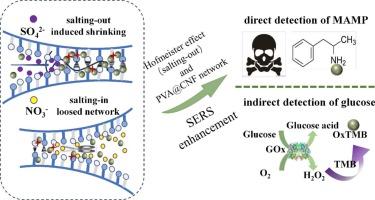Hofmeister effect-regulated poly(vinyl alcohol) @ cellulose nanofiber hydrogel-based SERS enhancement and sensing application
IF 12.5
1区 化学
Q1 CHEMISTRY, APPLIED
引用次数: 0
Abstract
Owing to high water absorption and molecular capture capabilities, hydrogels are ideal substrates for integrating with metal nanoparticles and widely used in surface-enhanced Raman scattering (SERS) sensing. Herein, a strategy is proposed to versatilely alter the SERS properties of hydrogels by tuning the aggregation states of polymer chains through ion-specific effects derived from the Hofmeister series. A polyvinyl alcohol@cellulose nanofiber/silver nanoparticle (PVA@CNF/Ag NPs) hybrid hydrogel was fabricated, incorporating both sulfate and nitrate anions into this hydrogel with enhancement of SERS signals. The kosmotropic Na2SO4 drives chain bundling in the PVA@CNF hydrogel matrix, thereby indirectly modulating the interparticle distance of Ag NPs therein. This facilitates the formation of electromagnetic “hot spots”, resulting in a marked improvement in SERS performance. Furthermore, the SERS performance of the hydrogels can be readily tuned across a broad range via adjusting anion type, concentration, and treatment duration. The optimal hydrogel exhibits a linear detection range of 0.001–100 ppm for methamphetamine (MAMP), with a coefficient of determination (R2) of 0.9836. When applied to urine analysis, it shows 85–110 % recoveries and a relative standard deviation (RSD) ~ 10 %. We further developed an indirect quantitative method for glucose, which features a lower limit of detection (10−7 M).

Hofmeister效应调控聚乙烯醇@纤维素纳米纤维水凝胶基SERS增强及传感应用
由于水凝胶具有较高的吸水性和分子捕获能力,是与金属纳米颗粒结合的理想底物,广泛应用于表面增强拉曼散射(SERS)传感。本文提出了一种策略,通过从Hofmeister系列中衍生的离子特异性效应来调节聚合物链的聚集状态,从而全面改变水凝胶的SERS特性。制备了聚氯乙烯alcohol@cellulose纳米纤维/银纳米粒子(PVA@CNF/Ag NPs)混合水凝胶,该水凝胶中含有硫酸盐和硝酸盐阴离子,增强了SERS信号。亲宇宙性Na2SO4驱动PVA@CNF水凝胶基质中的链束,从而间接调节其中Ag NPs的粒子间距离。这有利于形成电磁“热点”,从而显著提高SERS性能。此外,通过调节阴离子类型、浓度和处理时间,水凝胶的SERS性能可以在很宽的范围内进行调节。最佳水凝胶对甲基苯丙胺(MAMP)的线性检测范围为0.001 ~ 100 ppm,决定系数(R2)为0.9836。应用于尿液分析,回收率为85 ~ 110%,相对标准偏差(RSD)为10%。我们进一步开发了葡萄糖的间接定量方法,该方法具有检测下限(10−7 M)。
本文章由计算机程序翻译,如有差异,请以英文原文为准。
求助全文
约1分钟内获得全文
求助全文
来源期刊

Carbohydrate Polymers
化学-高分子科学
CiteScore
22.40
自引率
8.00%
发文量
1286
审稿时长
47 days
期刊介绍:
Carbohydrate Polymers stands as a prominent journal in the glycoscience field, dedicated to exploring and harnessing the potential of polysaccharides with applications spanning bioenergy, bioplastics, biomaterials, biorefining, chemistry, drug delivery, food, health, nanotechnology, packaging, paper, pharmaceuticals, medicine, oil recovery, textiles, tissue engineering, wood, and various aspects of glycoscience.
The journal emphasizes the central role of well-characterized carbohydrate polymers, highlighting their significance as the primary focus rather than a peripheral topic. Each paper must prominently feature at least one named carbohydrate polymer, evident in both citation and title, with a commitment to innovative research that advances scientific knowledge.
 求助内容:
求助内容: 应助结果提醒方式:
应助结果提醒方式:


